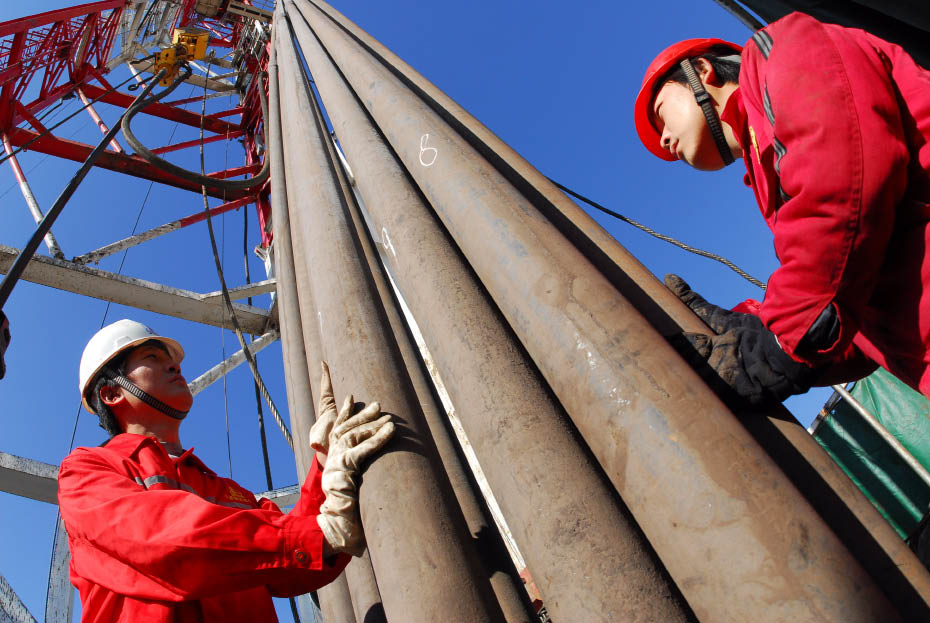China's Energy Development – 2011 to 2015
( 2011-January-10 14:43:18)
Stabilized Crude Oil Supply and Elevated Gas Consumption
 |
| Workers at an exploratory well at the Karamay Oilfield. |
From 2011 to 2015, China’s energy development will have seven priorities, the first of which is to promote efficient utilization of fossil fuels.
Measures adopted in this regard include those to upgrade coal mining enterprises, promote clean coal technology, speed up oil and natural gas exploration and optimize the development of thermal power. The NEA is aiming to stabilize crude oil supply and increase gas supply and consumption.
Within the industry it is acknowledged that China’s oil production has reached its peak and is leveling off. So the output is unlikely to grow unless massive oil deposits are discovered. By contrast, China’s natural gas production is likely to experience big gains in the next five years.
The NEA estimated China’s 2010 natural gas output at about 95 billion cubic meters. Add gas imports of 16 billion cubic meters and the 2010 gas consumption would hit a record high of 111 billion cubic meters.
Jiang Bing also wagers that by 2015 China’s gas consumption will reach 260 billion cubic meters, with its proportion in total energy consumption rising from the current 3.9 percent to around 8.3 percent.
But the estimates of industry insiders are more tempered. According to Yang Jianhong, deputy director of the oil and gas pipeline department at the China Petroleum Planning and Engineering Institute, China’s 2015 gas consumption is anticipated to exceed 200 billion and may hit 240 billion cubic meters, accounting for 6 to 7 percent of the national primary energy consumption.
Non-fossil Fuels Promoted
According to the NEA, to achieve by 2020 the goal to raise the use of non-fossil energy to 15 percent of primary energy consumption, and at the same time reduce carbon dioxide emissions by 40 to 45 percent per unit of GDP, non-fossil fuels will have to be providing 11 percent of China’s energy needs by 2015.
As the most competitive alternative to fossil fuels, hydropower plays a key role in realizing China’s emissions reduction goal. In 2010, China celebrated an historic moment: its installed hydropower capacity hit 200 million kilowatts. In the coming five years, the hydropower industry will experience another growth spurt. According to Jiang Bing, the current installed hydropower capacity is poised to expand to 250 million kilowatts by 2015.
China’s installed power capacity is expected to hit 1.43 billion kilowatts by 2015. That means between 2011 and 2015 another 400 million kilowatts of electricity generation capacity should be installed, of which 100 million kilowatts will come from hydropower, 36 million from nuclear power and 68 million from renewable energy sources such as wind power, estimates Zhang Yunzhou, president of the National Energy Research Institute.
Jiang Bing speculates that China is likely to have the world’s largest nuclear power capacity by 2015, some 39 million kilowatts.
China’s wind power capacity has multiplied many times over the past four years, and still maintains high-speed growth. The country has already surpassed the U.S. and ranks No.1 in the world in wind power capacity. Many industry insiders have predicted that China’s total installed wind power capacity will probably exceed 300 million kilowatts by 2020. The statistics released by the NEA indicate a figure of 35 million kilowatts in 2010. That means China’s wind-power capacity will see an eight-fold increase at least in the next 10 years.
The nation’s photovoltaic power capacity will see explosive growth from 2011 to 2015 as in 2010 the country started to invite tenders for its solar thermal and photovoltaic power projects.
Top Stories
China Posts Feb. Trade Deficit
Mainland to Crack down Illegal Organizing of Pregnant Women into HK
- Zhao Qizheng Stresses Public Diplomacy for Overseas Chinese Firms
China's Political Reform Must under CPC Leadership
China's Top Legislature Concluding Annual Session
- China's Parliament Adopts 12th Five-year Plan